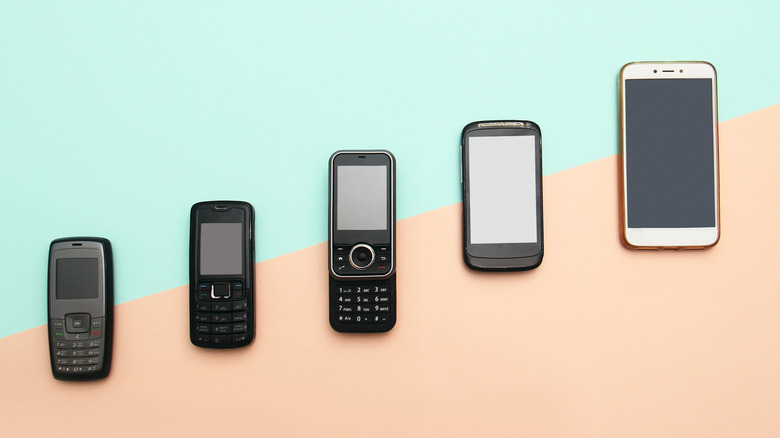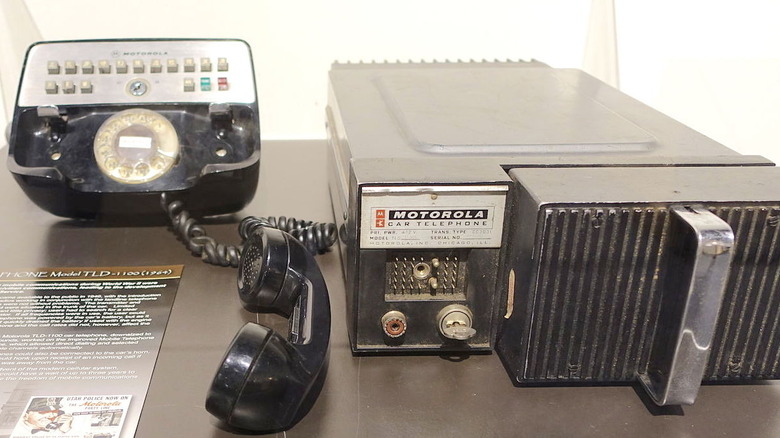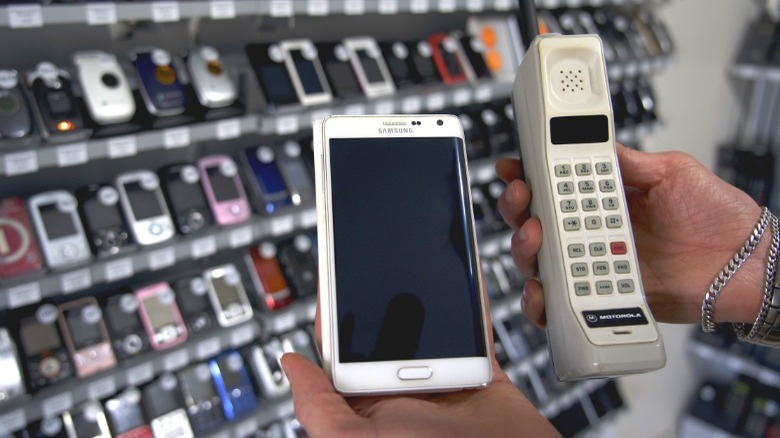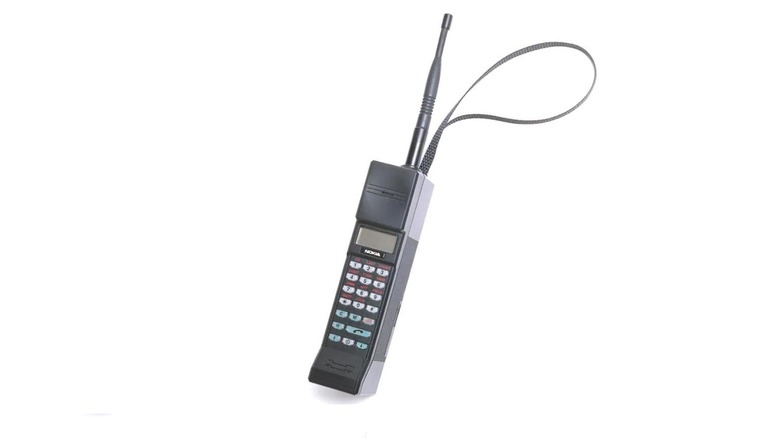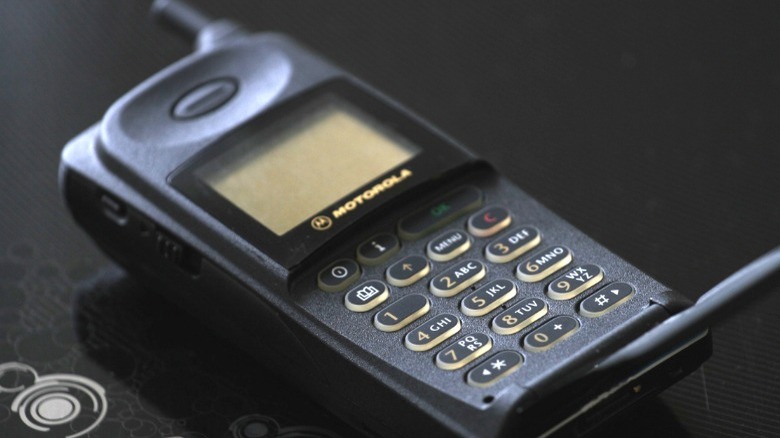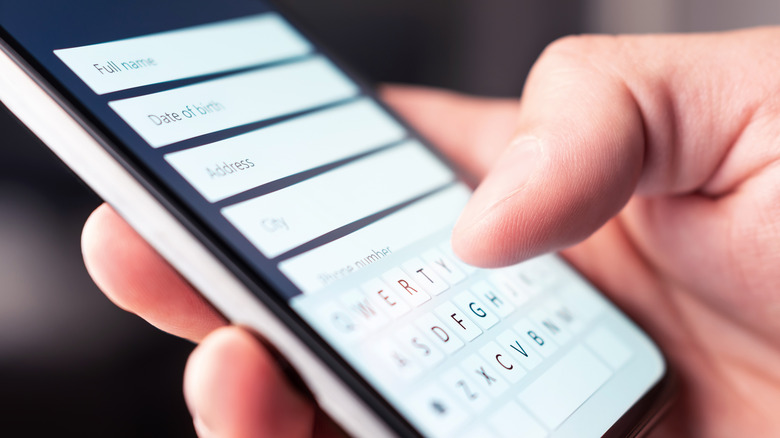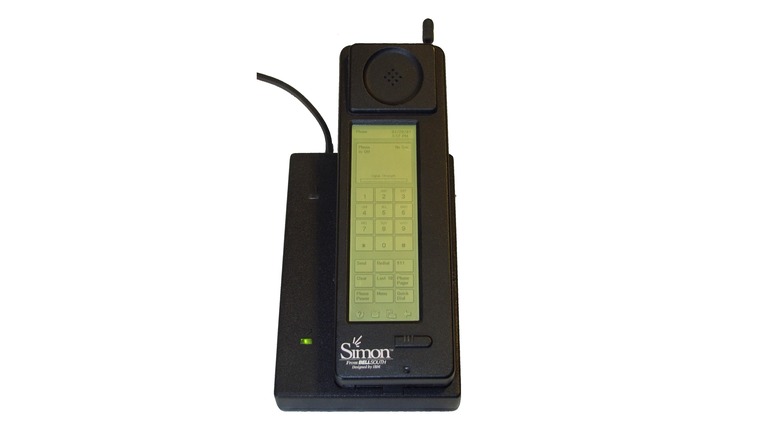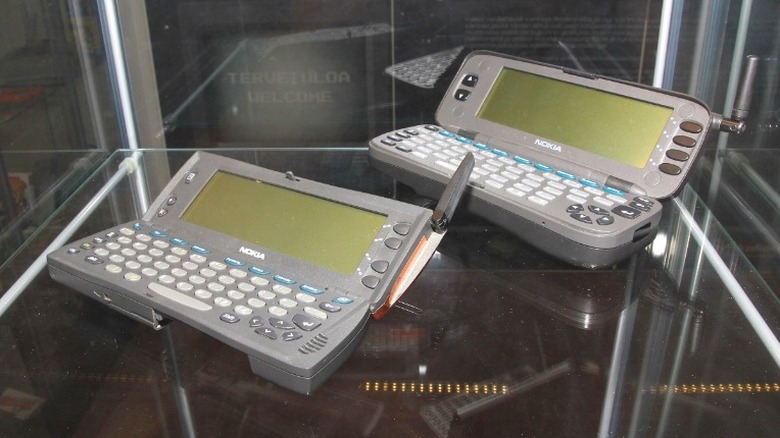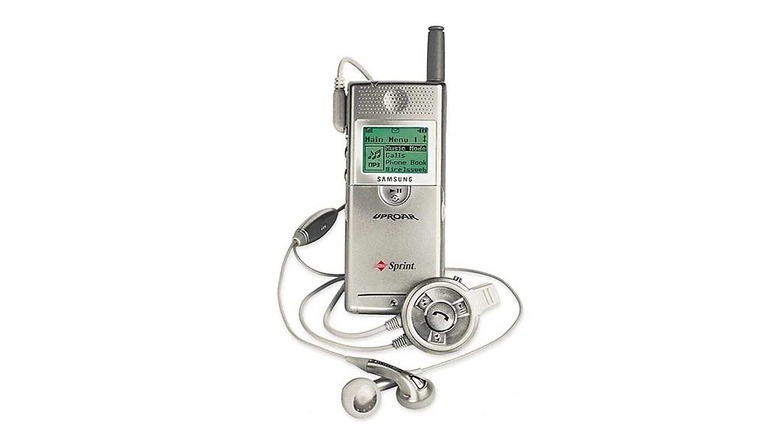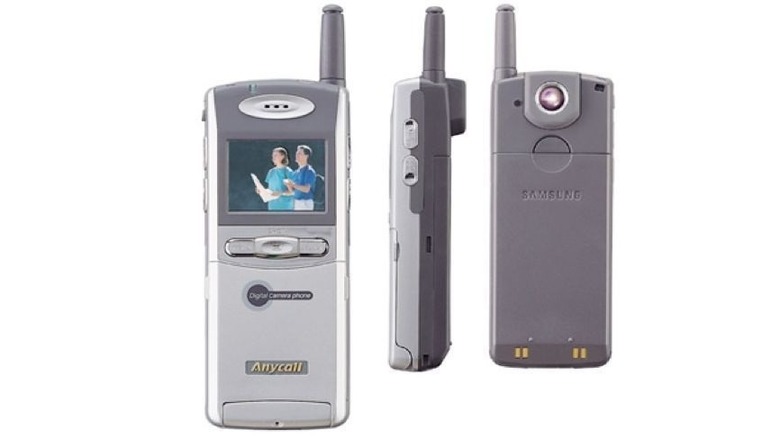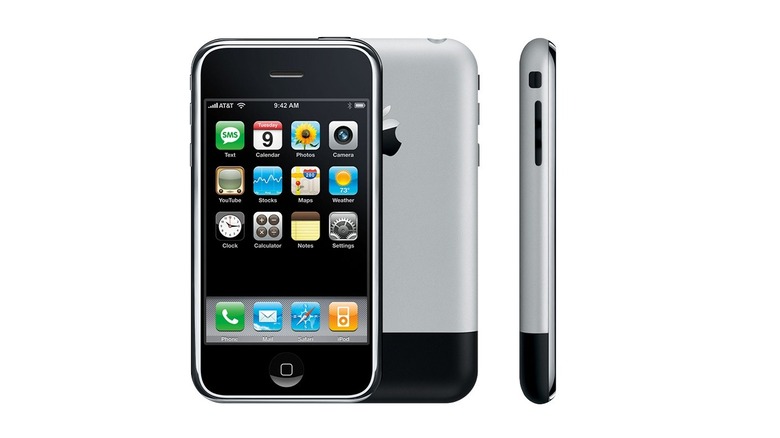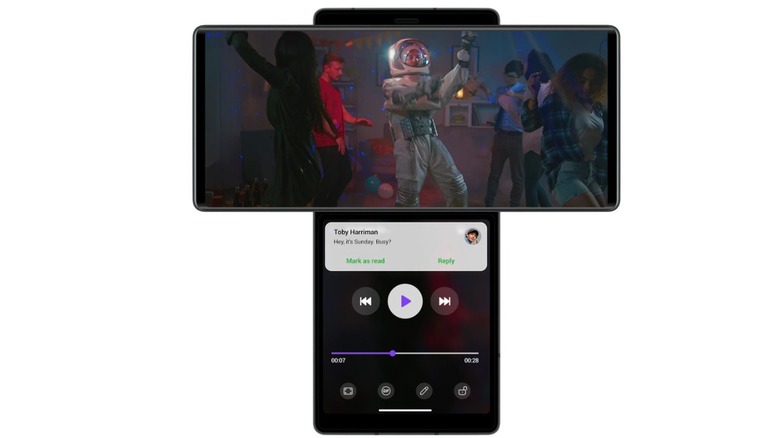The Stunning Transformation Of Cell Phones
We may receive a commission on purchases made from links.
Cell phones are a ubiquitous part of modern living. It's nearly impossible to imagine our lives today without them. What was once the domain of wealthy professionals is now so widespread that more than half of all children get their first phone before they turn 11 years old (via NPR). The ability to contact friends and family wherever you are and get answers from the internet at a moment's notice is taken for granted. Your phone gives you access to entertainment, communication, and real-time GPS. You can maintain your calendar of appointments, keep up on world events, and document your life's every moment all from a single device.
While cell phones feel like a fairly recent invention, their history spans the better part of a century — and that's not even taking into account their earlier origins in the home and mind of Alexander Graham Bell. Cell phones have come a long way from the very first mobile phones to the modern marvel nestled in your pocket. Like a jawless fish eventually evolving into a thinking ape capable of building spaceships, along the way, our phones have changed so much that they barely resemble their former selves. To understand how that stunning transformation happened, we'll have to go back to the beginning.
Car Phones
AT&T introduced the world's first mobile phones in 1946, but they were limited in scope and availability — such were the technological limitations of the time. A given area could only handle 11 or 12 channels, which meant if there were more users than that, the lines would get tied up and you'd have to wait to place or receive your call (via Britannica).
These early mobile phones also had staggering power requirements, outpacing any handheld batteries available at the time. To solve these power requirements, manufacturers placed them inside vehicles where they could rely on the comparatively large power source available in car batteries. As a result, they earned the popular moniker of "car phones." Giving your phone a home near the dashboard let you carry your communication with you away from the home for the first time, but you were still tethered. Considering that the car — or at least the battery — was a necessary component, they made for incredibly large mobile phones, indeed.
Things started to change when phone manufacturers realized they could add more users by breaking an area up into units or cells. That's where cell phones got their names. The only trouble was frequencies were limited, at least until the FCC offered up a mostly unused part of the UHF band in 1968. Then, finally, things started falling into place and the beginnings of the cell phone were born.
The World's First Cell Phone
Meanwhile, Motorola was also working on cellular phone technologies and hoped to beat AT&T to market, according to Wired. That's something they achieved in 1973 when Martin Cooper, an engineer at Motorola, called Joel Engel at AT&T to let Engel know he'd lost the race. Winning the scramble for a new technology is impressive enough, but using that very same technology to rub your win in your competitor's face is next-level shade.
The phone itself, dubbed the DynaTAC 8000X, left a little something to be desired by today's standards. But considering it was the early '70s and Cooper had nothing to compare it to, he probably didn't know what he was missing.
It weighed in at 2.5 pounds and had a talk time of only 35 minutes, after which it needed to recharge for roughly 10 hours. That's a far cry from the level of convenience we're used to today, but it's plenty for throwing dirt in your rival's eye and it set humanity down a path toward nearly universal mobile communication.
Nokia Enters the Picture
Nokia is no longer the power player in the cell phone market it once was. In 2013, it dipped to roughly 3% market share, down from 48% at its 2007 peak (via Statista). But, Nokia was in the game almost from the jump.
Released in 1987, the Nokia Mobira Cityman took the foundations laid down by Motorola and improved upon them. It gained popularity when it was seen being used by Mikhail Gorbachev, then President of the Soviet Union (via Microsoft Devices Blog).
Being the communication method of choice for world leaders wasn't the only thing the Cityman had going for it. It was almost a full pound lighter than the DynaTAC, coming in at just under 800 grams. Talk time also improved to just shy of an hour with a four-hour recharge time (via Nokia Museum). That's not great, but it's a substantial improvement on both fronts as compared to its predecessors. Still, it was a hulking piece of equipment, and its size was overshadowed only by its price. As explained by Phone Arena, getting one in your hand (it certainly wouldn't fit in the average pocket) would set you back the equivalent of about $10,000 if it were sold today.
Motorola MicroTAC: The First Flip Phone
Like most kinds of evolution, things tend to change slowly at first before rapidly ramping up. In the realm of cell phone technology, the Motorola MicroTAC 9800X might be considered the beginning of that curve. Not to be outdone by Nokia, the company which brought us the first true cell phone came out swinging in 1989 with the world's first flip phone.
When compared with previous devices, it was considerably smaller and more lightweight. That was due to its innovative folding design. The mouthpiece folded up when not in use, covering up the buttons. This served not only to protect the buttons, but also to reduce its overall profile. According to Android Authority, the MicroTAC came in at about 300 grams, or less than a pound. It was among the first cell phones to be small enough to fit comfortably in a pocket — at least when it was folded up — and it laid the groundwork for countless folding phones in the years to come.
In fact, the design was so successful for Motorola that it stuck around, with minor modifications, for nearly a decade until 1998 (via Mobile Phone Museum). Perhaps part of the appeal was the satisfying feeling of answering and ending calls by flipping the mouthpiece open or closed, something which is sadly lacking in today's devices.
The First Text Message
Up until this point, most of the innovation focus was in reducing the overall size of cell phones while improving their battery life, but not much had been done by way of functionality. All of that was about to change as 1992 came to a close.
On December 3, 1992, Neil Papworth sent the world's first text message. At the time, he was working as a programmer for Vodafone and sent the message to Richard Jarvis, a Vodafone executive. It's unclear if Papworth or Jarvis understood the gravity of what they had achieved or how it would impact global communication in the coming decades, and there's little in the message to indicate their feelings. It read simply, "Merry Christmas."
Jarvis received the message on an Orbitel 901, a hulking phone weighing over 4.5 pounds. In truth, it could hardly be considered a mobile phone at all, but it was the first device to function on a GSM network. Sadly, the Orbitel was incapable of responding to the message and it went unanswered (via NPR).
Despite inauspicious beginnings, that first message turned out to be fitting as text messaging soon became a gift to us all, liberating us from needing to answer phone calls. Though it probably couldn't have been predicted at the time, this marked the first important shift in phone functionality as it moved toward the devices we're familiar with today.
IBM Simon: The First Smartphone
As explained by Cambridge Wireless, there's some contention about which device earned the honor of being the first smartphone. That contention is due largely to disagreement on precisely what qualifies as a smartphone and the fact that the term didn't emerge until after several contenders were already on the market.
While it looks startlingly different from modern smartphones, many people consider IBM's Simon Personal Communicator to have been the first. Released in 1992, it had a number of functions that wouldn't be popularized in the wider market until a decade and a half later.
To look at it is to see a perfect marriage between old and new technologies. At first glance, it has more in common with cell phones of old, a consequence of its boxy construction and matte finish. What set it apart, however, was a large LCD touchscreen conspicuously taking up most of its front. That screen paired with an included stylus and was capable of sending and receiving emails, faxes, and pages. It also had a built-in address book, file folder, calendar, and more (via Insider). Despite an impressive suite of functions, the Simon only sold about 50,000 units and didn't capture the market in the way later smartphones would. Sometimes it's less about function and more about timing.
Cell Phones Get the Internet
While the Simon didn't make quite the splash IBM might have hoped, it did herald a change in the way people were communicating which would come to a head in the mid-'90s. The internet was a burgeoning technology, but uptake was starting to soar, particularly in the United States. By 1997, roughly 20% of people in North America were online, and the numbers were continuing to climb (via Our World in Data). Likewise, approximately 20% of people in the United States had a cell phone at this time (via Statista). This presented a looming opportunity for cell phone providers to unite the two technologies.
AT&T took the first crack at an internet-enabled cell phone, developing a prototype phone called the PocketNet, but that phone never made it to market. However, in 1996, the Nokia 9000 Communicator did (via Mobility Arena). The Communicator's clamshell design opened up to reveal a full QWERTY keyboard and a substantial screen capable of accessing online content. The user experience was admittedly sparse, relying on WML (wireless markup language) to translate sites to something the phone could read. A few years later, Nokia upped the ante with the Nokia 7110, the first phone to come with a built-in Wireless Application Protocol browser (via Mobile Phone Museum).
Samsung UpRoar: The First MP3 Player Phone
Playing music from your phone feels like a no-brainer today, but that wasn't always the case. Today's mobile streaming music functionality can trace its origins back to the Samsung UpRoar, released in 2000. Even before the first iPod hit the market and made MP3 players the device du jour, Samsung succeeded in mashing together a cell phone with an MP3 player.
Built on the framework of a fairly standard flip phone, the UpRoar included web browsing, voice dialing, and memo recording in addition to 64 megabytes of built-in music storage. According to CNN, that was about enough to hold an hour's worth of music, and the phone was capable of 11 hours of play time on a single charge. Pulling music files directly onto the phone from the internet wasn't yet possible, but that wouldn't become a feature of mobile devices for several years. Instead, files were transferred to the phone by way of a USB cable and included MusicMatch software.
In order to accommodate the MP3 player's functions, a large play/pause button was built front and center, and it remained accessible even when the phone was flipped closed. It might have been a little ahead of its time, but it laid the groundwork for yet another shift in cell phone functionality.
The First Camera Phone
There's some contention about which phone was the first to incorporate a camera. Much like the smartphone debate, it's a matter of strictly defining what counts as a camera phone and what doesn't. As explained by CNET, several relatively early devices crossed the functionality of a phone and a camera, like the Olympus Deltis VC-1100 which allowed users to upload photos using phone lines. While it certainly used cell phone technology, it wasn't a phone. Other devices used dongles to connect a camera to a separate cell phone, allowing them to communicate with one another. What was lacking was a unified device which served both purposes. Whether or not those early examples constitute camera phones is in the eye of the beholder.
Samsung was likely the first to pull off a true camera phone when they released the SCH-V200 in 2000. It included a 0.35-megapixel camera and was capable of storing 20 photos on the phone. The only trouble was you had to connect it to a computer to retrieve your pictures (via Digital Trends).
Sharp probably gets the credit for putting all the pieces together later that same year, incorporating both a camera and the ability to send photos over the air into their phone. Wherever you draw the line, a camera quickly became a required component of nearly all cell phones.
The First iPhone
By the mid-2000s, cell phones had become nearly universal, and manufacturers had experimented with all kinds of cool functionalities from taking pictures and listening to music to sending text messages and accessing the internet. The market was primed for someone to put it all together into one seamless package. As we've established, the iPhone wasn't the first smartphone, but it did popularize the form factor like never before. It would influence just about every cell phone that came after it. Regardless of the kind of phone you have in your pocket, it's likely it can trace a lot of its DNA back to the first iPhone.
When Apple's first version dropped in 2007, it lacked many of the functions you know and use today. As explained by Insider, it didn't have an app store, it couldn't shoot video, and it couldn't even send a photo in a text message. What it did well, perhaps better than any phone before or since, is create a platform for experimentation and innovation which has carried forward ever since.
Each iPhone iteration has built upon the last. While the changes from year to year and phone to phone may have been small, the cumulative evolution between the first iPhone and its descendants is nearly as staggering as the transformation of cell phones overall.
Resurrecting Old Form Factors
Despite all of the incredible functions found in modern cell phones, they lack something in their aesthetic. That too can be traced back, at least to some degree, to that first iPhone. Ever since, cell phones have stripped themselves down to sleek bricks of smooth glass and metal. While user interfaces can differ somewhat, for the most part, if you've held one phone you've held them all. You'd be forgiven for missing the RAZR's satisfying clack as you flipped it closed or the dopamine hit of the Sidekick's whirling display.
In pursuit of improved functionality and streamlined designs, we lost something of the tactile experience cell phones used to offer. That might be poised to change. Some manufacturers are attempting to marry modern technology with designs of the past to give consumers foldable screens and dual monitors complete with moving parts we haven't seen in quite some time. Some of these phones, like the LG Wing and the Lenovo C Plus, feel almost ripped from a futuristic sci-fi flick, equal parts weird and incredible.
It's unclear where the future of cell phones will take us, but a look through the history of the technology proves that progress tends to come from trying something new, even if that something didn't work the first time around.
